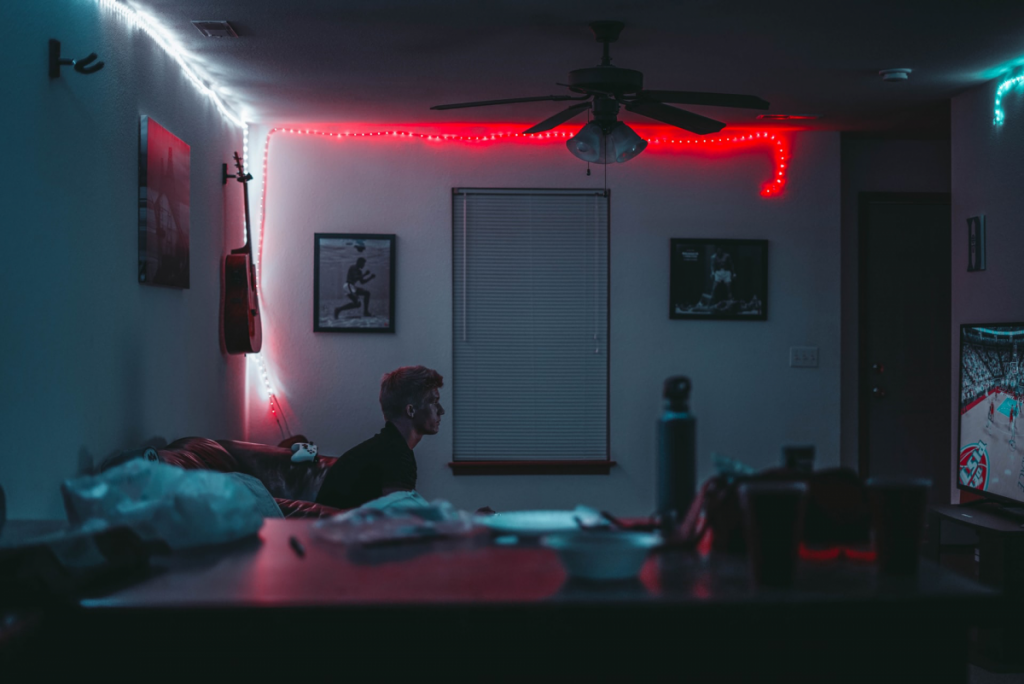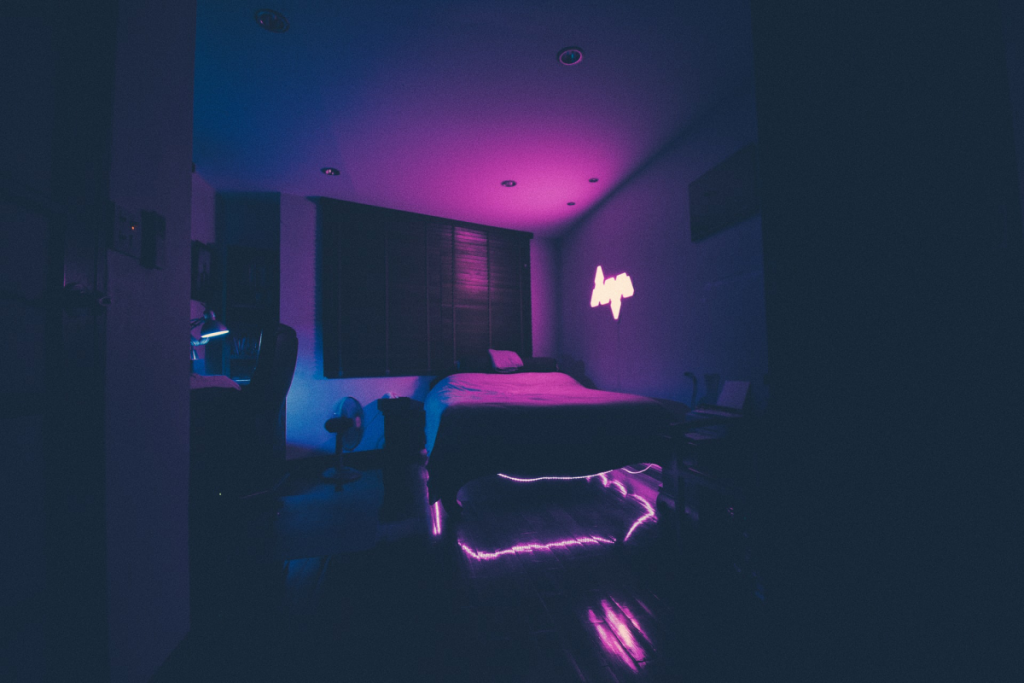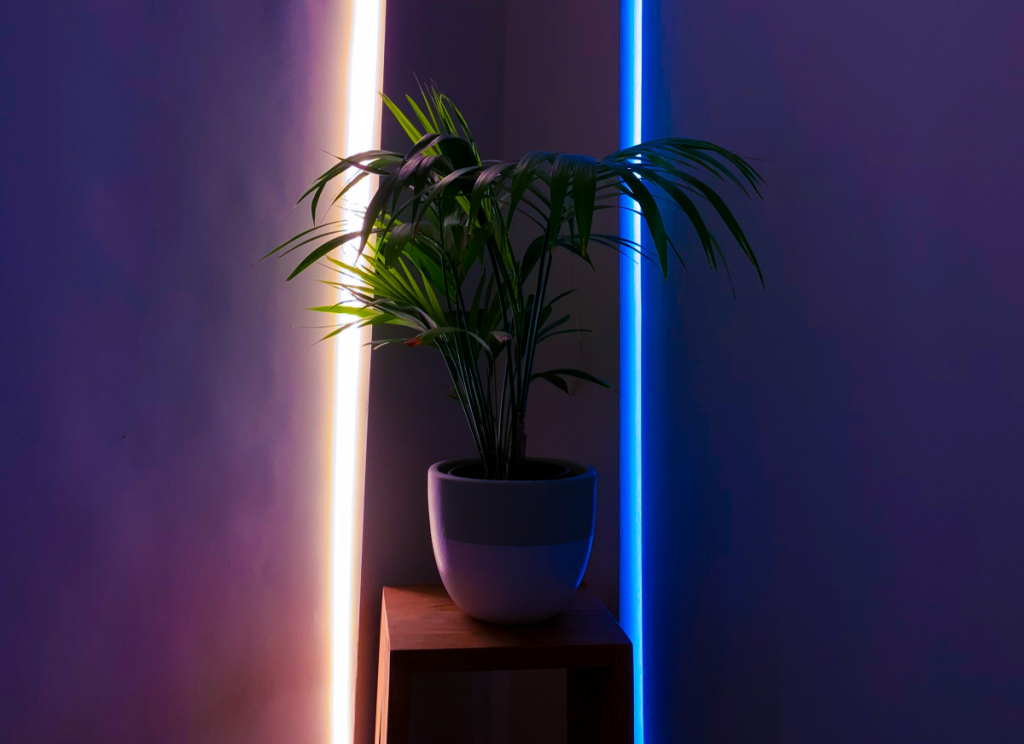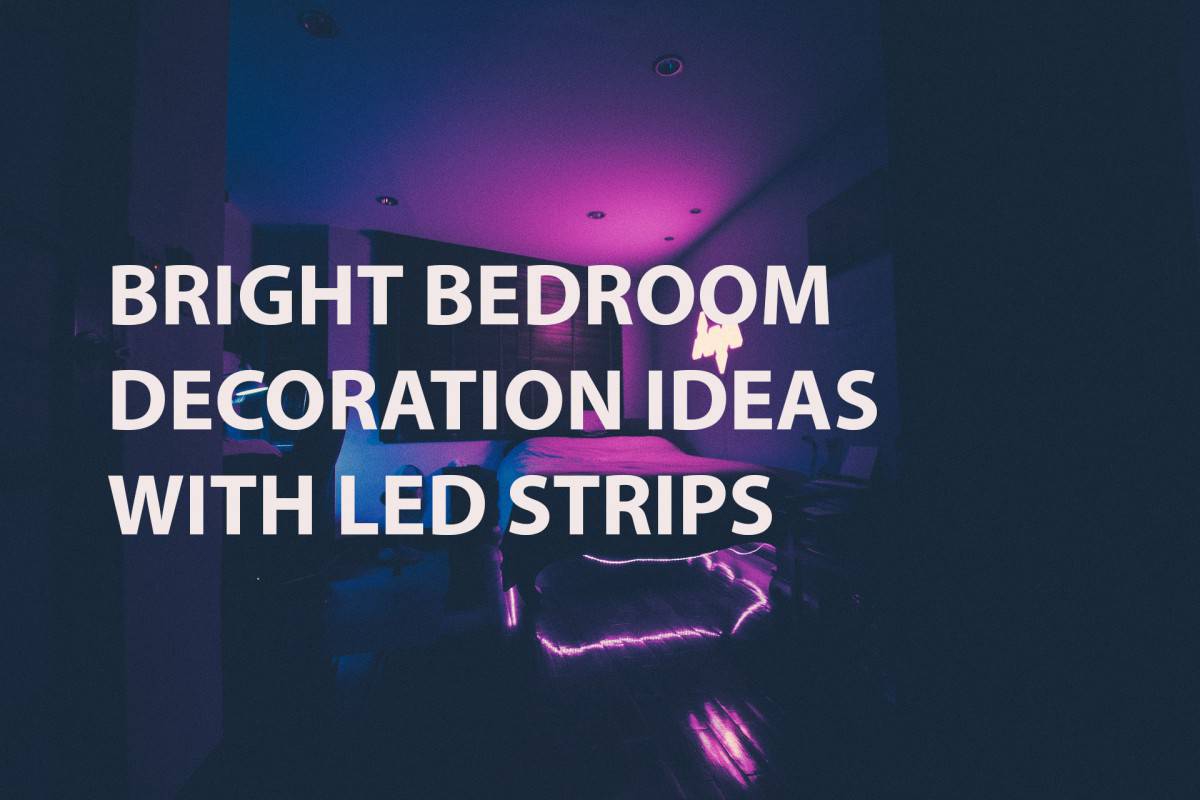In this guide, I’ll be showing you why LED strips are an instant mood setter without having to spend so much on cliché decorations that wouldn’t have any other purpose than just to sit in your room.
Your bed, ceiling, closet, and even behind the television in your bedroom are the best places to decorate with LED strips. LED strips are perfect for these spots in the bedroom since they are more versatile and sustainable than other lighting types.
You will also be learning why LED strips are the easiest way to jumpstart your game when it comes to adding some flavor to parts of your bedroom by discussing where to put them specifically.
LED Strips – Brightening Up With Less Energy
Low Energy Consumption And Sustainable
LED lighting, in general, is 75% to 90% more efficient than other forms of conventional lighting.
These figures make meters of LED strips ideal for decorating large areas because they provide lighting while consuming less.
On average, a meter of a LED strip is only around 7.2 watts. At 800 lumens, halogen bulbs consume around 43 watts while LED lighting consumes only around 9-11 watts.
On top of being energy efficient, they’re also environmentally and economically sustainable.
To illustrate, a LED light bulb with the same brightness as previous generation types of lighting such as halogen or incandescent produces 20% less heat than its predecessors.
On average, the LED lighting longevity ranges from 50,000-100,000 hours depending on quality, usage, and maintenance.

Versatility
LED strips are incredibly versatile. Decorating different parts of your bedroom means that you’d have to go for varying lengths of LED strips, depending on the situation.
LED strips are available for purchase at different lengths, but you could opt for custom cutting by yourself if you want to explore.
Going over bumps and irregularly shaped objects when decorating with LED strips also wouldn’t be a problem due to their flexibility.
Different light colors were almost always only available in white, yellow, or warmer shades in the past.
With the innovation of LED strips, you could go from red to green and even dim to bright in an instant without having to go through the inconvenience of changing bulbs.
If you’re looking for another important aspect in decorating, which is the convenience of setting up, LED strips are readily available with double-sided tapes, so you wouldn’t have to worry about drilling or clipping.
If you’re enjoying this article then why not check out these related articles after finishing this one:
Hue Bridge Compatible LED Strips
Lifx Beam vs Nanoleaf – Who’s the best?!
Hue Sync Explained – Beginners Guide With Pictures!
All Philips Hue Serial Number Locations!
Can Phillips Hue Lights Strobe – Let’s Find Out!
The Bedroom – LED Strip Decoration Haven
There are unlimited possibilities when picking the correct placement of LED strips in your bedroom.
We spend most of our time in our bedroom to get rest, dress up, and work for those who have their designated workstations in their bedroom.
If you’re trying to look for ways to aid your sleep at night, you could consider decorating your bedroom with LED strips.
While most of us prefer sleeping in total darkness, dim LED strips could set the mood for you by creating a relaxing vibe if you’re having trouble sleeping at night.
If you have a workstation in your bedroom, LED strips could be useful in creating an atmosphere for focus work.
Here are a few bright ideas on the best places in your bedroom to decorate with LED strips!
Behind Your Headboard
You could begin decorating your room by going straight for the headboard. Since most headboards are plain and only just for functionality, most people would opt to install paintings, photographs, or any ornament above their headboard.
By decorating your headboard with LED strips, you’re getting rid of dull and mainstream decoration ideas.
Aside from making your bed look better overall, having LED strips behind your headboard dismisses the need for bedside lamps.
For some people who like to keep lighting sources on at night, installing LED strips would serve the same purpose that bedside lamps provide but in a much more creative way.

Installation tips
Assemble your purchased LED strip according to its accompanying instruction manual. Take note that you should be using the correct type of wiring and power unit with your purchased LED strip.
For the LED strip tape to entirely stick, make sure to wipe the surface of your headboard clean with a cloth wet with alcohol to clear it of any dust particles.
Be sure to let the surface dry before proceeding to stick your LED strips. Stick the LED strips behind the headboard by covering the whole perimeter of the rear of your headboard.
Bonus tip: When going through the corners of your headboard, don’t forcibly bend your LED strip into a 90-degree corner. Doing this creates a space that lets air contact the tape, which lessens its stickiness.
There are alternative ways when going through corners while installing your LED strip.
First, you could opt to purchase corner connectors. You could cut your LED strip and install corner connectors to rejoin them at the corners of your surface.
A more straightforward and more practical solution is to bend your LED strip into a loop at the corners.
Doing this keeps the spaces vulnerable to air contact minimal while reducing the tension your LED strip has to withstand.
This would work not just for your headboard but also for the other places in your bedroom where you want to install LED strips.
Cons
Installing LED strips on your headboard also comes with downsides. There is a tendency for your bed to move towards the wall and possibly crush your LED strips against them.
While having LED strips installed at the back of your headboard, it would be difficult to spot significant damages on them unless you regularly check.
Considering this, you’d have to allot space in between your bed and the wall to protect your LED strips.
Although LED lighting generates significantly less heat than other forms of lighting, it is unavoidable that you would feel at least a small amount of heat while sleeping if you have them installed at the back of your headboard.
Under Your Bed Frame

This placement is ideal for beds that have a lot of space under them. Like your headboard, installing LED strips under your frame would significantly improve the overall aesthetic of your bed.
Having LED strips under your frame would provide you with sufficient lighting at night without directly straining your eyes and possibly get you in the mood for sleep.
If you have LED strips installed under your bed, it would be easier to spot objects that might have accidentally gone under your frame.
Installation Tips
To make things easier for you to install LED strips under your bed frame, you can opt to remove your bed foam and turn your bed sidewards against the wall.
To maximize lighting, cover the whole rectangular perimeter under your bed frame.
Installing your LED strips individually under each of the slats where your foam goes over is also an option.
Cons
As previously mentioned, installing LED strips under your bed frame would be difficult and a waste of lighting if there isn’t much space between your bed and the floor.
If you store things under your bed, these objects could obstruct your LED lighting.
Since you’re placing LED strips under your bed, it would be difficult to spot significant damages unless you go out of your way to check for them regularly.
Bedroom Closet
The bedroom closet is also an excellent place to install your LED strips. Having LED strips in your wardrobe makes it easier to look for and distinguish clothes apart from each other.
If you’re the type of person who keeps a color theme for your clothes and closet, adding the same color of LED strip lighting would be a creative addition for storing your clothes.
If you want to conserve energy, you could modify your LED strips so that they only light up once your closet doors are open
Installation Tips
Be sure to temporarily remove clothes from your closet to avoid any obstruction while you install your LED strips.
Since your wardrobe is a vast space, you could consider installing your LED strips on its ceiling, floor, or the area behind where your hanging clothes go.
Installing LED strips on the inner side of your closet doors is also a viable option.
Cons
Having LED strips installed inside your closet would be a waste if you barely have clothes stored inside.
On the other hand, if you have many clothes, installing LED strips and all its components would take up space that you could potentially use to store more clothes.
Managing wires that bring power to your LED strips is also a challenge since you have to consider that you must keep your closet doors closed.
Ceiling Cob Lights
Installing LED strips for ceiling cob lights in your bedroom is my favorite decoration idea.
Instead of going for old-fashioned chandeliers, revolutionize ceiling lighting with LED strips. Installing LED strips as cob lighting works by reflecting the light on your ceiling from your LED strips, which are hidden from plain sight.
The ceiling is also a suitable place to put your LED strips if you don’t want to spend money on pin lights and chandeliers.
Installation Tips
Observe proper caution when installing LED strips as cob lights by using a step ladder instead of stepping on a chair or a table.
Attach your LED strips along the perimeters of your allocated space for cob lighting.
You could also opt to tap your LED strips to your main switches if you want to lessen visible wirings.
Cons
Installing LED strips as cob lighting means that you have to buy a longer strip of LED and therefore spend more money initially.
If you’re going to install LED strips at the height of your ceiling, you’re going to have to drill them in to make sure they would not fall.
Drilling would require more money to spend on materials and a longer process.
If your bedroom ceiling does not have allotted space for cob lighting, having LED strips on your ceiling wouldn’t look as good as if you had the proper room for them. P
Behind Your Tv

If you spend a lot of time watching television in your bedroom, adding LED strips at the back of your flat-screen wouldn’t be such a bad idea.
By attaching LED strips at the back of your television, the lighting coming from your LED strip would serve as bias lighting. This works the same way with the long LED strips at the screen’s perimeters found in movie theatres.
Bias lighting is any source of light located at the back of your screen or monitor.
Having bias lighting lessens the glare coming from your television screen by contrasting the illumination from your screen and therefore making it less straining on your eyes.
Installation Tips
When installing LED strips, be sure to follow the instruction manual that came along with it. Stick your LED along the rectangular perimeters of the back of your television.
Be sure to allow at least half a meter between your tv and your wall to maximize your lighting.
Since you’re installing LED strips on another electronic device, be sure to manage your wires appropriately to avoid confusing them with your television and sound system chords.
Cons
Since televisions already heat up by themselves, adding a LED strip at the rear of your television screen would increase its temperature.
The heat coming from your television could also slowly deplete the stickiness of your LED strips.
Placing LED strips at the back of your television would also prove to be a hassle if your flat screen is wall mounted.
You’d have to go through unscrewing and unmounting your television only to realize later on that there is only a tiny amount of space between the wall and tv once you put it back.
LED Strips – Maximizing Them To Your Style
Now that you know where to place LED strips in your bedroom, you have to note how you could maximize your LED strip decorations.
Be sure that the LED strip you’re purchasing comes with a remote, so you wouldn’t have to stand up to press a switch to adjust the colors and brightness.
Going for a LED strip system that you could also link to a phone app would significantly make things more fun and convenient.
Conclusion
Placing LED strips at the right spots in your bedroom would make a significant difference in its whole vibe.
LED strips are bright and sustainable alternatives to decorating your bedroom without breaking the bank because of power costs.
Although any kind of decoration can be put in your bedroom, placing LED strips at the perfect places induces that cozy and homey feeling that would surely make you love staying in your bedroom more!
If you’re enjoying this article then why not check out these related articles after finishing this one:
Hue Bridge Compatible LED Strips
Lifx Beam vs Nanoleaf – Who’s the best?!
Hue Sync Explained – Beginners Guide With Pictures!

